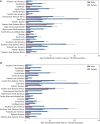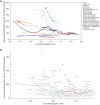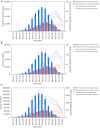Global trends in the burden of esophageal cancer, 1990-2019: results from the Global Burden of Disease Study 2019
- PMID: 36910098
- PMCID: PMC9992583
- DOI: 10.21037/jtd-22-856
Global trends in the burden of esophageal cancer, 1990-2019: results from the Global Burden of Disease Study 2019
Abstract
Background: Esophageal cancer is one of the leading causes of cancer death worldwide. A deeper understanding of the trends in annual incidence, mortality, and disability-adjusted life-years (DALYs) of esophageal cancer is critical for management and prevention. In this study, we report on the disease burden of esophageal cancer in 204 countries and territories between 1990 and 2019 by age, sex, and sociodemographic index (SDI).
Methods: Data on incidence, mortality, and DALYs were extracted from the Global Burden of Diseases, Injuries, and Risk Factors Study (GBD) 2019. The estimated numbers and age-standardized rates for esophageal cancer in 2019 are presented in this paper, as well as trends from 1990 to 2019. All estimates are presented as counts and age-standardized rates per 100,000 population, with 95% uncertainty intervals (UIs) for each estimate.
Results: In 2019, nearly 535,000 (95% UI: 467,000-595,000) new cases of esophageal cancer occurred globally. Esophageal cancer was responsible for more than 498,000 (95% UI: 438,000-551,000) deaths and 11.7 million (95% UI: 10.4-12.9 million) DALYs. Worldwide age-standardized rates of esophageal cancer, including incidence, deaths, and DALYs, have declined since 1990. However, the trends differ across countries and territories. Notably, there was a nonlinear but generally inverse correlation between age-standardized DALY rates and SDI. Higher age-standardized incidence and death rates were observed in males compared to females, and both increased with age. Regarding risk factors, smoking, alcohol use, and high body-mass index were 3 predominant contributors to esophageal cancer DALYs in 2019 for both sexes worldwide.
Conclusions: This study found a global reduction in the esophageal cancer burden, but substantial heterogeneity remains across regions and countries. Hence, the identification of high-risk groups and the exploration of specific local strategies and primary prevention efforts are required.
Keywords: Esophageal cancer; disease burden; incidence; mortality; risk factor.
2023 Journal of Thoracic Disease. All rights reserved.
Conflict of interest statement
Conflicts of Interest: All authors have completed the ICMJE uniform disclosure form (available at https://jtd.amegroups.com/article/view/10.21037/jtd-22-856/coif). Jianxing He serves as Executive Editor-in-Chief of Journal of Thoracic Disease. The other authors have no conflicts of interest to declare.
Figures







References
-
- Fitzmaurice C, Abate D, Abbasi N, et al. Global, Regional, and National Cancer Incidence, Mortality, Years of Life Lost, Years Lived With Disability, and Disability-Adjusted Life-Years for 29 Cancer Groups, 1990 to 2017: A Systematic Analysis for the Global Burden of Disease Study. JAMA Oncol 2019;5:1749-68. 10.1001/jamaoncol.2019.2996 - DOI - PMC - PubMed
-
- Fitzmaurice C, Allen C, Barber RM, et al. Global, Regional, and National Cancer Incidence, Mortality, Years of Life Lost, Years Lived With Disability, and Disability-Adjusted Life-years for 32 Cancer Groups, 1990 to 2015: A Systematic Analysis for the Global Burden of Disease Study. JAMA Oncol 2017;3:524-48. 10.1001/jamaoncol.2016.5688 - DOI - PMC - PubMed
LinkOut - more resources
Full Text Sources
